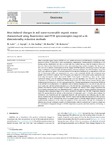Mostrar o rexistro simple do ítem
Heat-Induced Changes in Soil Water-Extractable Organic Matter Characterized Using Fluorescence and FTIR Spectroscopies Coupled With Dimensionality Reduction Methods
| dc.contributor.author | Lado, Marcos | |
| dc.contributor.author | Sayegh, J. | |
| dc.contributor.author | Gia-Gadñay, Alex | |
| dc.contributor.author | Ben-Hur, Menachem | |
| dc.contributor.author | Borisover, Mikhail | |
| dc.date.accessioned | 2023-03-28T15:57:25Z | |
| dc.date.available | 2023-03-28T15:57:25Z | |
| dc.date.issued | 2023 | |
| dc.identifier.citation | Lado, M., Sayegh, J., Gia-Gadñay, A., Ben-Hur, M., & Borisover, M. (2023). Heat-induced changes in soil water-extractable organic matter characterized using fluorescence and FTIR spectroscopies coupled with dimensionality reduction methods. Geoderma, 430, 116347. https://doi.org/10.1016/j.geoderma.2023.116347 | es_ES |
| dc.identifier.uri | http://hdl.handle.net/2183/32799 | |
| dc.description.abstract | [Abstract] Water extractable organic matter (WEOM) is a very mobile and reactive soil OM fraction, critical in the translocation of carbon (C) from soils to other environmental compartments. Transformations of WEOM due to soil heating can have implications not only at a local scale, but in places far away from the location of the event. However, their accurate characterization is costly when analyzing a large number of samples. The objectives of this work were to identify common patterns for the changes in WEOM caused by the heating of various soil types using a combination of spectroscopic and dimensionality reduction techniques. Six soils from Spain, Kenya and Israel were collected at depths 0–10 cm and analysed before and after heating in air to temperatures of 300 and 600 °C. Fluorescence EEMs were measured in soil–water extracts containing WEOM, and decomposed using parallel factor (PARAFAC) analysis. The FTIR spectra were measured in freeze-dried extracts and further analysed using non-negative matrix factorization (NMF). Total organic C and SUVA254 values of the extracts experienced changes with the heating treatments that were soil dependant. Four PARAFAC and three NMF components were sufficient to characterize WEOM changes in all soils, which showed common thermal transformation patterns irrespective of their origin and properties. Thermal transformation of fluorescent WEOM led to the increase in the proportion of a component with an emission maximum at Ex 300/Em 392 nm, and to a lower extent one with the emission maximum at Ex 300/Em 426 nm. Concomitantly, the proportion of components with emission maxima at longer excitation wavelengths was reduced. These changes occurred at the lowest heating temperature and were maintained at 600 °C, and they seem to indicate a depletion of fluorescent components more conjugated, bigger in size, and an enrichment in smaller ones. The NMF components obtained from FTIR spectra showed an increase of the proportion of compounds with Csingle bondO bonds, more oxidized. No correlations were found between the components obtained with each method, thus indicating that the information obtained from the fluorescence EEMs-PARAFAC analysis and the NMF decomposition of FTIR spectra is complementary. It can be concluded that there is a common pattern of WEOM changes induced by thermal soil transformations irrespective of the origin and properties of the soils studied, and that the combination of different spectroscopic techniques coupled with dimensionality reduction methods can be used as a simple and low-cost method to fingerprint changes in WEOM composition, in general, and those caused by soil heating, in particular. | es_ES |
| dc.language.iso | eng | es_ES |
| dc.publisher | Elsevier | es_ES |
| dc.relation.uri | https://doi.org/10.1016/j.geoderma.2023.116347 | es_ES |
| dc.rights | Atribución-NoComercial-SinDerivadas 4.0 Internacional | es_ES |
| dc.rights.uri | http://creativecommons.org/licenses/by-nc-nd/4.0/ | * |
| dc.subject | Soil heating | es_ES |
| dc.subject | EEMs | es_ES |
| dc.subject | Mid-infrared spectra | es_ES |
| dc.subject | PARAFAC | es_ES |
| dc.subject | Non-negative matrix factorization (NMF) | es_ES |
| dc.title | Heat-Induced Changes in Soil Water-Extractable Organic Matter Characterized Using Fluorescence and FTIR Spectroscopies Coupled With Dimensionality Reduction Methods | es_ES |
| dc.type | info:eu-repo/semantics/article | es_ES |
| dc.rights.access | info:eu-repo/semantics/openAccess | es_ES |
| UDC.journalTitle | Geoderma | es_ES |
| UDC.volume | 430 (February 2023) | es_ES |
| UDC.startPage | 116347 | es_ES |
| dc.identifier.doi | 10.1016/j.geoderma.2023.116347 |






